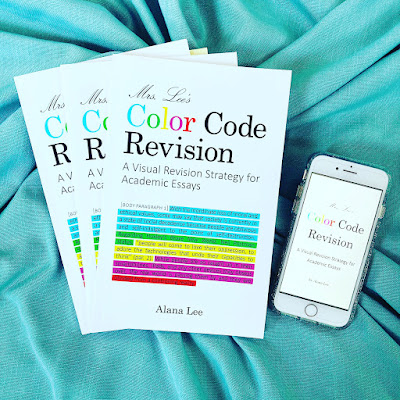Hi, friends. I want to introduce you to my brainchild, Mrs. Lee's Color Code Revision: A Visual Revision Strategy for Academic Essays. While teaching composition at the college level, I realized that many students don't know how to revise their academic essays beyond grammar and punctuation. So I developed this strategy to help students pinpoint the content in each paragraph that could be improved.
Mrs. Lee’s Color Code Revision reveals an innovative revision strategy for improving academic essays. Students often don’t know where to begin when asked to revise an essay beyond grammar and spelling errors. Color Code Revision gives students a starting place as well as a strategy to focus their revision efforts into creating well developed paragraphs with supporting details. This book starts with how to color code and then moves on to commonly asked questions regarding color coding and its connection to the revision process.
The Color Code Revision strategy works best with formal academic essays, including various types of research papers, research reports, rhetorical or textual analyses, position papers, evaluations, summary response essays, and book reviews. This strategy can also be used to help improve informal writing during the drafting process.
The Color Code Revision strategy has been used successfully at the college level for developmental English courses, freshman composition, and advanced composition classes. Additionally, Mrs. Lee’s Color Code Revision is a great writing resource for middle schools, high schools, homeschool, and tutoring centers. It will benefit those needing “chunking strategies” to help with learning differences.
Mrs. Lee’s Color Code Revision can be used:
- as a supplement to any writing handbook or English textbook (as this book does not provide lessons on grammar or conventions).
- as a supplement text to any class that requires the writing of at least one polished essay.
- during in-class revision workshops. It works best if the instructor models the process on several paragraphs, preferably using a student sample of the same genre as the assigned essay being revised. Then the student can use this book as a guide to begin the color code revision process in his or her own paper.
- during peer reviews.
- as a self-guided revision tool for any student who needs to revise an academic essay even when this book is not a required text for the course.
Praise for Mrs. Lee’s Color Code Revision: “I loved the Color Code Revision workshop!! I have never seen anything like it and now I use it with every class paper I write.”
“What I found most helpful is the colorful rainbow to help me execute a great flow in my essay.”
“The rainbow Color Code Revision is an amazing tool!”
If this could help you or someone you know, please check out the kindle/ebook and paperback versions on Amazon and Apple Books.
*Note:
Because so much of success depends on one’s ability to write, Mrs. Lee
believes everyone should have access to books that improve writing
skills, so she keeps the kindle edition priced low for wide
affordability.

















































